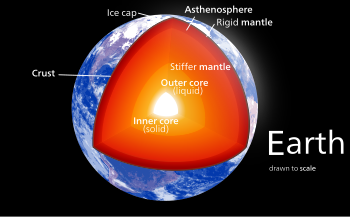
Back आंतरिक क्रोड ANP لب داخلي Arabic Nucleu internu AST Barisfer Azerbaijani Земно ядро Bulgarian Nucli intern Catalan Innerer Erdkern German Núcleo interno de la Tierra Spanish Sisetuum Estonian Barne nukleo Basque


- upper mantle
- lower mantle
- inner core
- Mohorovičić discontinuity
- core–mantle boundary
- outer core–inner core boundary
Earth's inner core is the innermost geologic layer of the planet Earth. It is primarily a solid ball with a radius of about 1,220 km (760 mi), which is about 20% of Earth's radius or 70% of the Moon's radius.[1][2]
There are no samples of the core accessible for direct measurement, as there are for Earth's mantle.[3] The characteristics of the core have been deduced mostly from measurements of seismic waves and Earth's magnetic field.[4] The inner core is believed to be composed of an iron–nickel alloy with some other elements. The temperature at its surface is estimated to be approximately 5,700 K (5,430 °C; 9,800 °F), about the temperature at the surface of the Sun.[5]
The inner core is solid at high temperature because of its high pressure, in accordance with the Simon-Glatzel equation.[6]
- ^ Cite error: The named reference
monner2010was invoked but never defined (see the help page). - ^ Cite error: The named reference
eng1974was invoked but never defined (see the help page). - ^ "Earth's Interior". National Geographic. 18 January 2017. Archived from the original on 11 April 2021. Retrieved 17 November 2021.
- ^ Cite error: The named reference
alle1995was invoked but never defined (see the help page). - ^ Cite error: The named reference
alf2007was invoked but never defined (see the help page). - ^ "From Core to Crust: Defining Earth's Layers | Exploring Earthquakes".